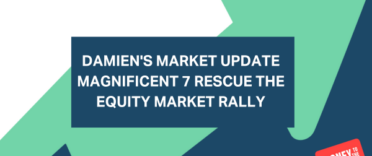The 128th episode of my weekly YouTube show where I discuss what is happening in investment markets and what to look out for. This week I talk about how the currency market can provide clues as to where markets are heading.
Each show lasts between 5-10 minutes and is aimed at DIY investors (including novices) seeking contemporary analysis to help them understand how investment markets work.
Subscribe to my YouTube channel to receive my weekly analysis of investment markets or alternatively, you can listen via my weekly Midweek Markets podcast below.
Midweek Markets weekly podcast
Other ways to watch, listen and subscribe
You can listen to other episodes and subscribe to the show by searching 'Money to the Masses' on Spotify or by using the following links:
Abridged transcript - Midweek Markets episode 128
At the end of last week’s show I warned to keep an eye on bond yields as a seemingly new trend had appeared to be gathering pace in the bond market, fuelled by surprisingly dovish monetary policy decisions from the US Federal Reserve, the Bank of England and the European Central Bank. In previous weeks, bond yields had tumbled, for example the 10 year US treasury yield had fallen from 1.67%, to a six-week low of 1.43% Similarly the 10 year UK gilt yield had fallen from 1.21% to 0.82% over the same period.
With so many investors betting against bonds, the rally in bond prices (remember bond yields move inversely to bond prices) caught a number of institutions off-guard and brought about a spot of short covering. This is essentially where investors reverse their bets that bond yields will keep rising, by ultimately having to buy bonds to do so, so pushing up the price of bonds. This vicious circle of bond buying drives the market higher in what is known as a short-squeeze.
But when the overarching driver of market move is a short-squeeze the reversal of the squeeze, when the forced sellers run out, can be just as dramatic as the initial surge that started it all. This reversal occurred after last week’s shows, just as new US inflation data showed that inflation had climbed to 6.2% in October making it the fastest year-on-year increase since 1990. That in itself wasn’t a shock but when combined with a fall in demand for bonds, even from forced buyers, this caused the 10 year US treasury yield to explode higher to 1.646%. We saw similar, albeit less dramatic, moves higher in other bond markets including the 10 year UK gilt yield which attempted and failed to break and hold above 1%.
Even the news that UK inflation has hit 4.2% the highest in a decade was met with little reaction from UK bond investors, as it appears that higher inflation and ultimately higher interest rates are already baked into the market pricing. But ultimately bond yields on both sides of the Atalntic and further afield are still in an uptrend, even though they appear to be entering a period of consolidation as investors hang on every word/action from central banks in an attempt to front-run the next big market move.
Similarly the situation in equity markets has been one of consolidation within an overall uptrend. The S&P 500 has pulled back a little from its all-time high of 4,701.70 on 8th November to sit at 4688. But that is not particularly noteworthy. 4,700 is a psychologically significant barrier to break, but some technical analysts think it is only a matter of time and indeed before it happens, and are now targeting the 5,000 level perhaps as early as the year end during the seasonal Santa rally.
In the UK the FTSE 100 is still hovering around 7,300 while the Euro Stoxx and the DAX continue to pursue new all-time highs despite a concerning 4th COVID wave emerging in Europe and in particular in Germany.
But while markets are still trying to position themselves by second-guessing central bank policy, in the absence of any new information they are also starting to place bets that there will be a possible divergence between key central bank policies as each juggles higher with inflation and economic growth in their respective economies.
No clearer can this be seen than in currency markets. In recent weeks the pound has tumbled from $1.356 to as low as $1.343. Last time I said to keep an eye on the September low of 1.3411 because if that falls then we could be heading down towards $1.31. Although the pound has strengthened to near $1.35 we are not out of the woods yet. The reason for the continued weakness of the pound against the dollar is that despite both the Bank of England (BOE) and the Fed keeping interest rates low, the latter has already started tapering its QE programme which at least signals its intent on tightening monetary policy. The BOE so far has been all talk and no action.
In Europe the Euro has fallen in value against both the pound and the US dollar, hitting a 16 month low against the latter. That’s because markets are betting that the ECB will resist raising interest rates, even when the BOE and Fed do. The market has started to realise that not all three central banks will or have to move at once and institutional investors are beginning to adjust their positionings.
It means that we could see a repricing of other assets too, not just in currency markets if the narrative continues to gain traction. Going back to government bond markets, perhaps this explains the strong rebound in yields in US treasuries, at the same time as a more contained rally in UK gilt yields. The message is don’t be surprised if a divergence in central bank policy becomes a major investment theme going into 2022.



